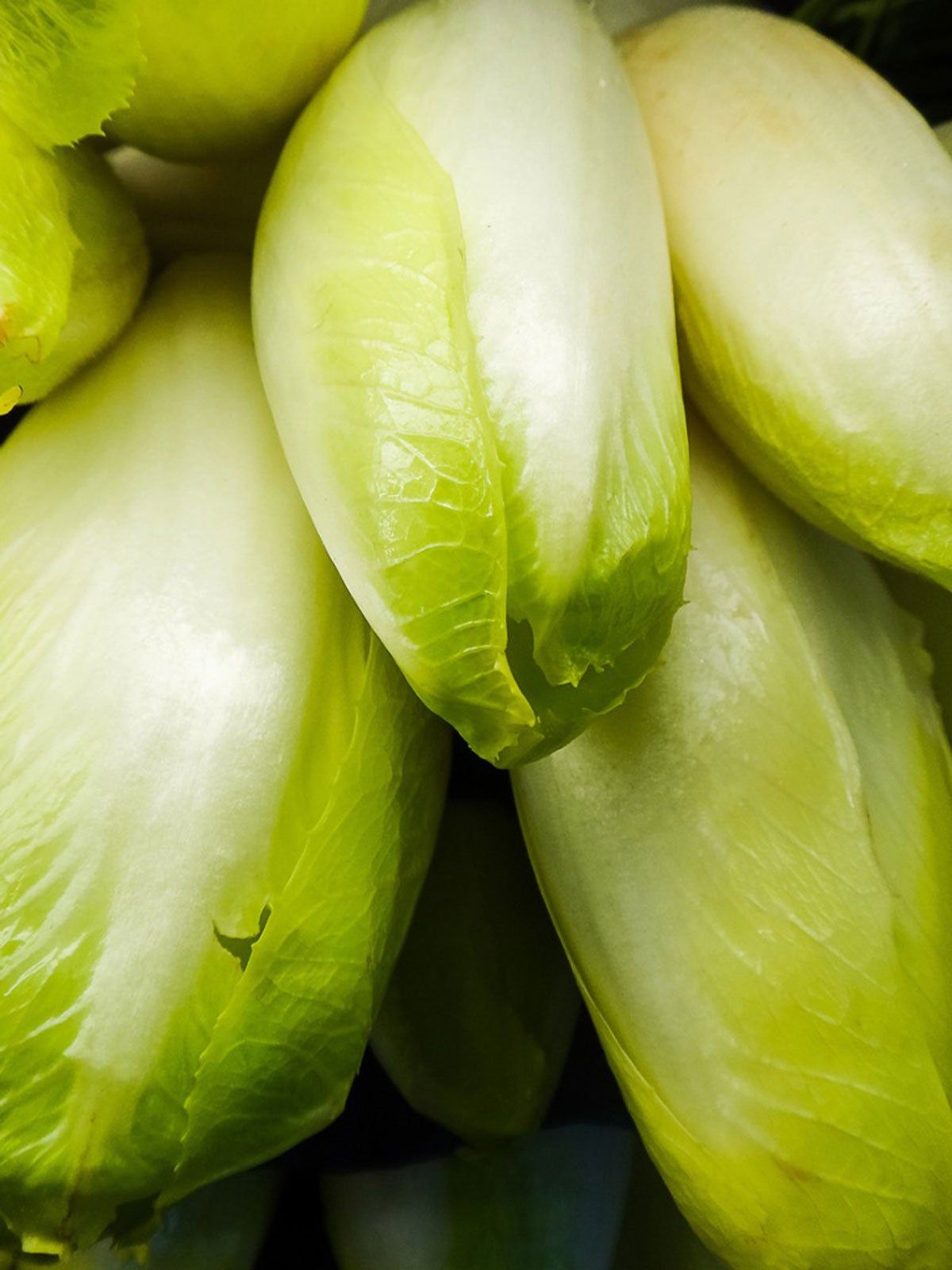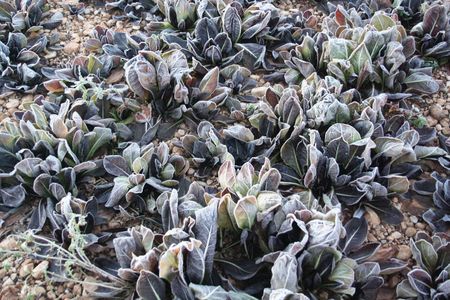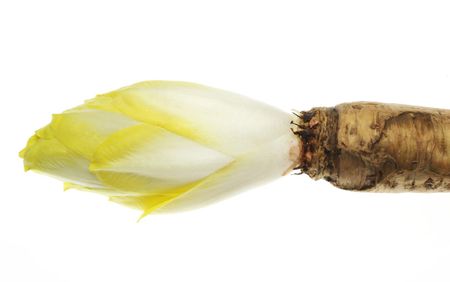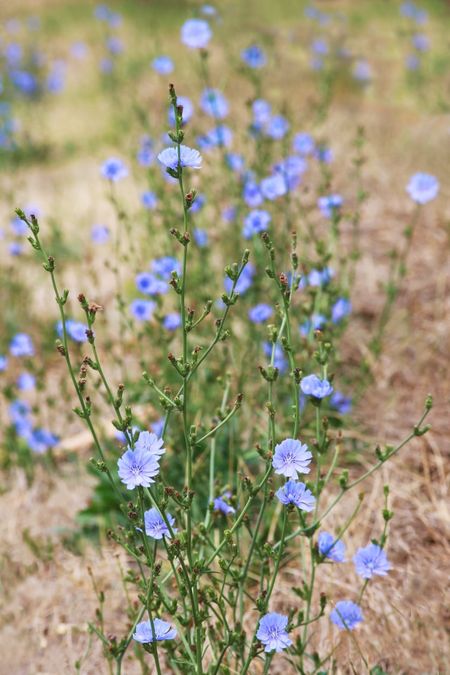Belgian Endive Info – Tips For Growing Witloof Chicory Plants


Witloof chicory (Cichorium intybus) is a weedy-looking plant. That's not surprising, as it's related to the dandelion and has frilly, pointed, dandelion-like leaves. What is surprising is that witloof chicory plants have a double life. This same weed-like plant is responsible for the production of chicons, a bittersweet winter salad green, which is a culinary delicacy in the U.S.
What is Witloof Chicory?
Witloof chicory is an herbaceous biennial, which was grown centuries ago as a cheap substitute for coffee. Like the dandelion, witloof grows a large taproot. It was this taproot that European farmers grew, harvested, stored, and ground as their knock-off java. Then about two hundred years ago, a farmer in Belgium made a startling discovery. The witloof chicory roots he'd stored in his root cellar had sprouted. However, they didn't grow their normal dandelion-like leaves.
Instead, the chicory roots grew a compact, pointed head of leaves much like Cos lettuce. What's more, the new growth was bleached white from lack of sunlight. It had a crispy texture and a creamy, sweet flavor. The chicon was born.
Belgian Endive Info
It took a few years, but the chicon caught on and commercial production spread this unusual vegetable beyond the borders of Belgium. Due to its lettuce-like qualities and creamy, white color, the chicon was marketed as white or Belgian endive.
Today, the United States imports approximately $5 million worth of chicons annually. Domestic production of this vegetable is limited, but not because witloof chicory plants are difficult to grow. Rather, the development of the second stage of growth, the chicon, requires exact conditions of warmth and humidity.
How to Grow Belgian Endive
Growing witloof chicory is, indeed, an experience. It all begins with the cultivation of the taproot. The witloof chicory seeds can be sown directly into the ground or started indoors. Timing is everything, as a delay in transplanting into the garden can affect the quality of the taproot.
There's nothing especially difficult about growing witloof chicory roots. Treat them as you would any root vegetable. Plant this chicory in full sun, spacing plants 6 to 8 inches (15-20.5 cm.) apart. Keep them weeded and watered. Avoid high nitrogen fertilizers to encourage root development and prevent the overproduction of leaves. Witloof chicory is ready for harvest in the fall around the time of the first frost. Ideally, the roots will be about 2 inches (5 cm.) in diameter.
Gardening tips, videos, info and more delivered right to your inbox!
Sign up for the Gardening Know How newsletter today and receive a free copy of our e-book "How to Grow Delicious Tomatoes".
Once harvested, the roots can be stored for a period of time before being forced. The leaves are cut off approximately 1 inch (2.5 cm.) above the crown, side roots are removed, and the taproot is shortened to 8 to 10 inches (20.5-25.5 cm.) long. The roots are stored on their side in sand or sawdust. Storage temperatures are kept between 32 to 36 degrees F. (0-2 C.) with 95% to 98% humidity.
As needed, taproots are brought out of storage for wintertime forcing. They are replanted, completely covered to exclude all light, and maintained between 55 to 72 degrees F. (13-22 C.). It takes approximately 20 to 25 days for the chicon to reach a marketable size. The result is a tightly formed head of fresh salad greens which can be enjoyed in the dead of winter.

Laura Miller has been gardening all her life. Holding a degree in Biology, Nutrition, and Agriculture, Laura's area of expertise is vegetables, herbs, and all things edible. She lives in Ohio.
-
 Best Tomatoes For Containers: 10 Tastiest Varieties For Plentiful Produce In Compact Areas
Best Tomatoes For Containers: 10 Tastiest Varieties For Plentiful Produce In Compact AreasThese are the best tomatoes for containers that prove you don't need to have a large space or elaborate garden to grow delicious produce.
By Bonnie L. Grant
-
 Ultimate Potted Flowers For Spring: 8 Brilliant Blooming Options for Spring Containers
Ultimate Potted Flowers For Spring: 8 Brilliant Blooming Options for Spring ContainersCelebrate the most uplifting of seasons with the most dazzling container flowers imaginable. Here, we present some of the loveliest potted flowers for spring…
By Tonya Barnett
-
 Different Types Of Chicory: What Are Chicory, Endive, And Escarole
Different Types Of Chicory: What Are Chicory, Endive, And EscaroleEndive or Chicory? If you’ve ever found yourself wondering which you should use in a recipe, you’ve come to the right place.
By Laura Miller
-
 Chicory Winter Care: Learn About Chicory Cold Tolerance
Chicory Winter Care: Learn About Chicory Cold ToleranceChicory in winter generally dies back and will spring anew in spring. This occasional coffee substitute is easy to grow and a fairly reliable perennial in most zones. Learn more about chicory cold tolerance and what you can do to help protect the plants here.
By Bonnie L. Grant
-
 Forcing Chicory Plants – Learn About Chicory Root Forcing
Forcing Chicory Plants – Learn About Chicory Root ForcingHave you ever heard of forcing chicory plants? Chicory root forcing is a common procedure that transforms the roots into something marvelous. If you are growing chicory, and are wondering “should I force chicory,” the resounding answer is yes! Learn more here.
By Amy Grant
-
 Is Chicory An Annual Or Perennial: Learn About Chicory Lifespan In Gardens
Is Chicory An Annual Or Perennial: Learn About Chicory Lifespan In GardensPlant lifespan is often a subject of debate. For instance, many annuals in the north are actually perennials or biennials in the south. So, is chicory an annual or perennial? Click this article to see which… or if there is a third, unexpected choice.
By Bonnie L. Grant
-
 Treating Sick Chicory Plants: Learn About Common Chicory Diseases
Treating Sick Chicory Plants: Learn About Common Chicory DiseasesIf you are growing chicory in your garden, it is disappointing to see sick chicory plants. If this happens to you, you probably want some answers on “what’s wrong with my chicory.” Click this article for a discussion of chicory plant problems.
By Teo Spengler
-
 Potted Chicory Care – Can You Grow Chicory In A Container
Potted Chicory Care – Can You Grow Chicory In A ContainerGenerations of herbalists have used this chicory herb as a treatment for maladies ranging from upset stomach and jaundice to fever and gallstones. Growing potted chicory plants is a great way to enjoy them up close and in small spaces. Click here to learn more.
By Mary H. Dyer
-
 Types Of Chicory – Chicory Plant Varieties For Gardens
Types Of Chicory – Chicory Plant Varieties For GardensIf you decide to plant chicory in your garden, you’ll want to scope out different chicory plant varieties. Each has its own characteristics, uses, and growth requirements. Click here to learn about different chicory plants and how to choose among the many varieties of chicory.
By Teo Spengler
-
 Chicory Plant Uses: What To Do With Chicory Plants
Chicory Plant Uses: What To Do With Chicory PlantsYou’ve probably heard of chicory and you may even have this ornamental plant in your garden. But you may not be sure what to do with chicory or how you can start using chicory from the garden. What is chicory used for? Click here to find out.
By Teo Spengler